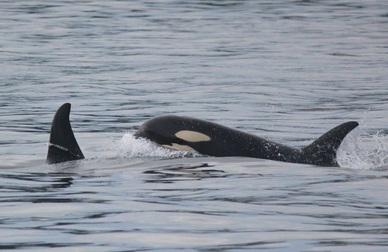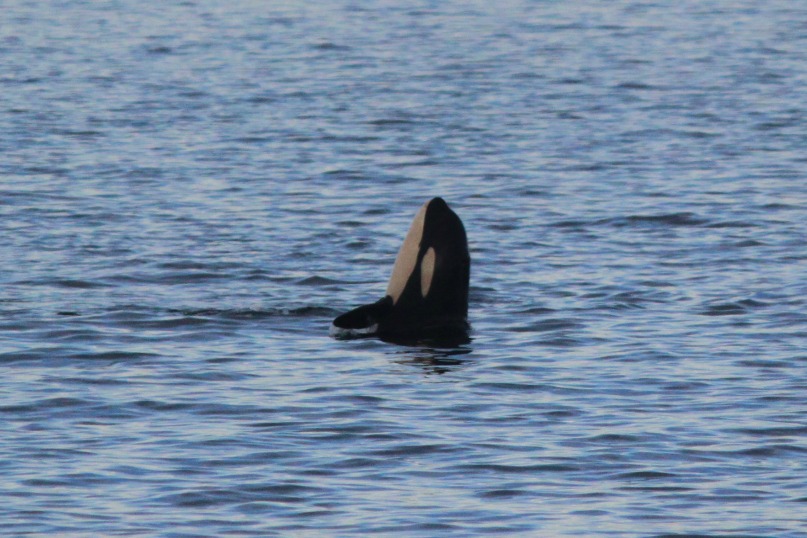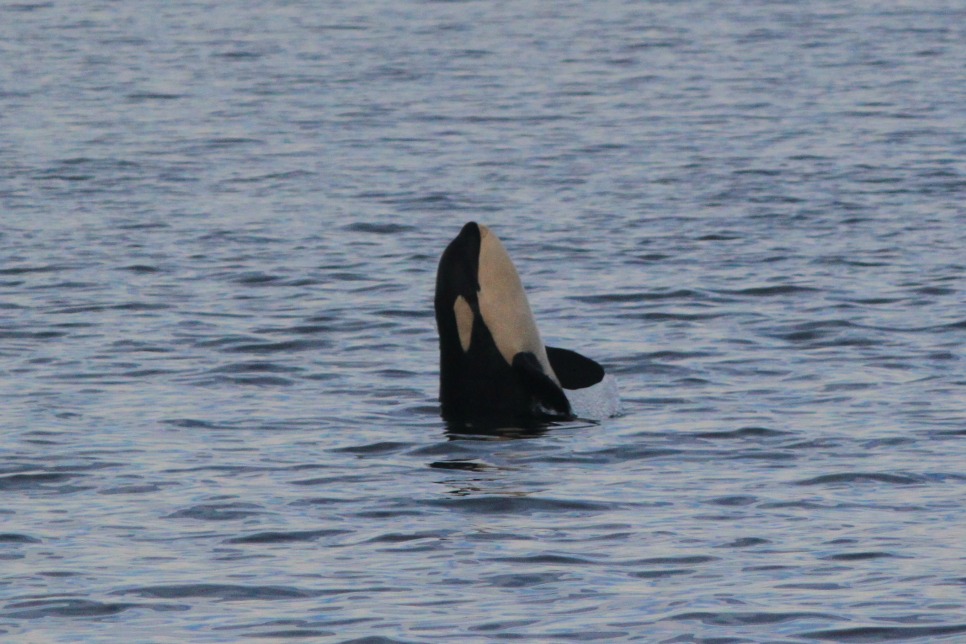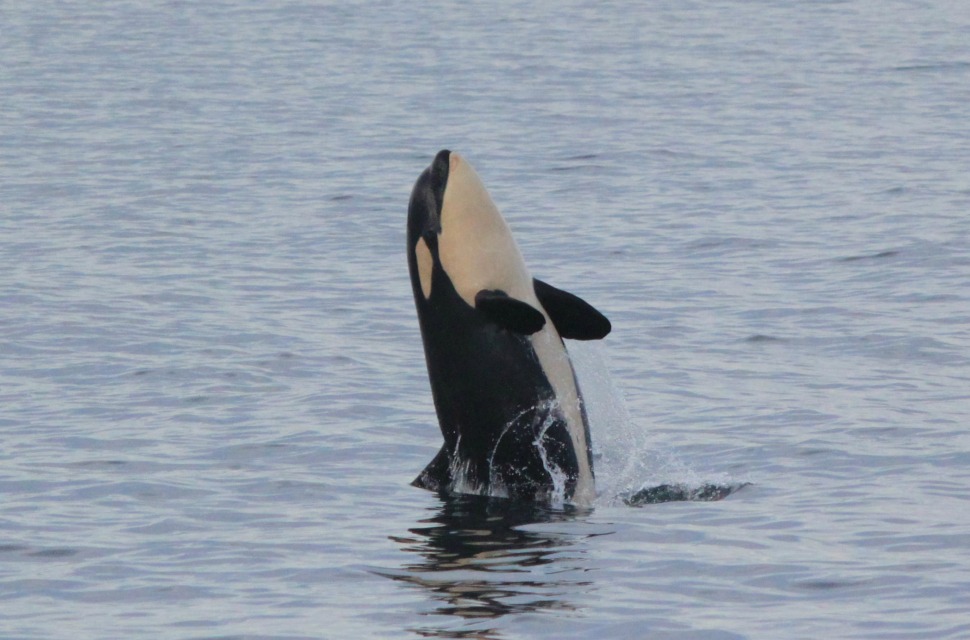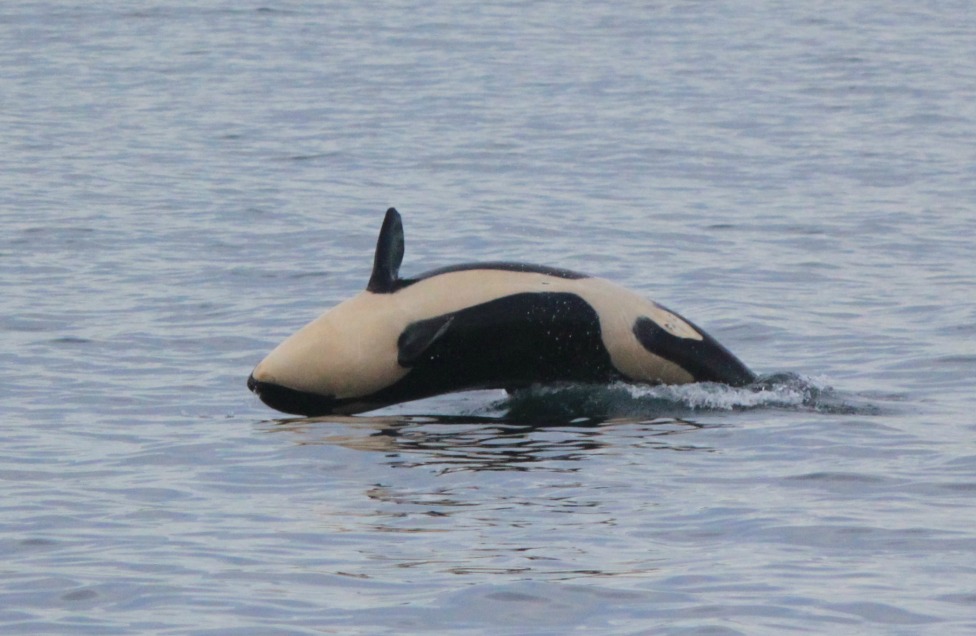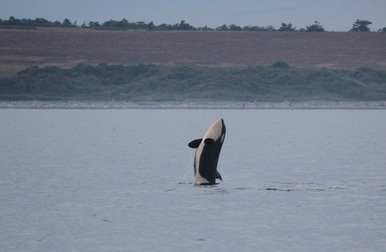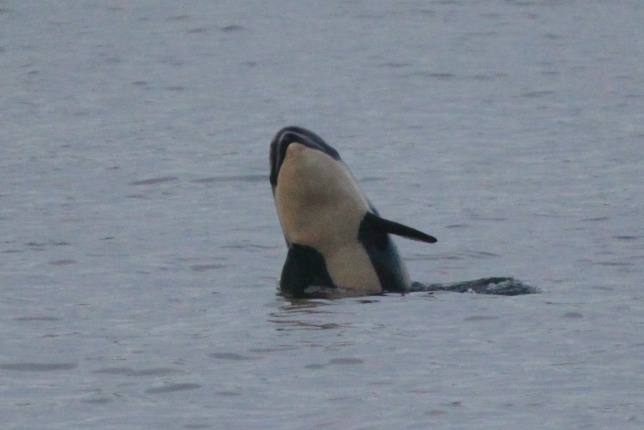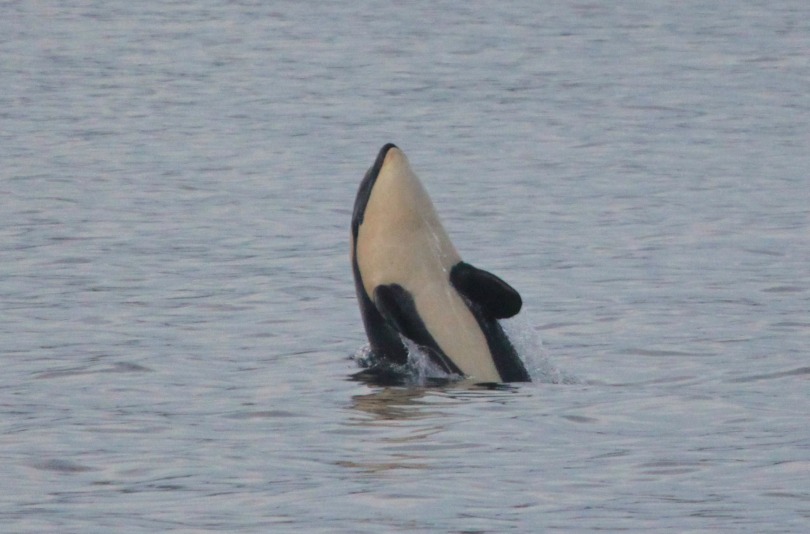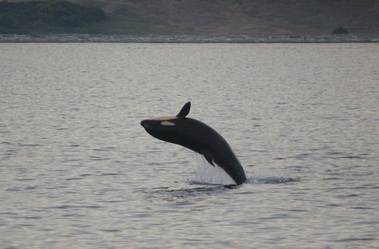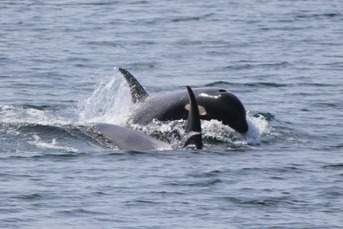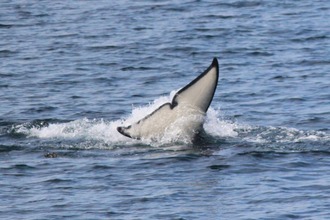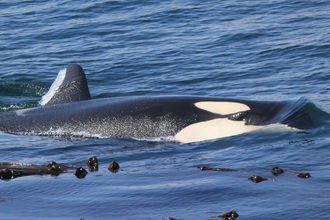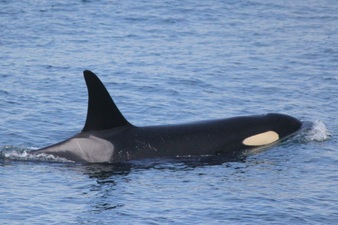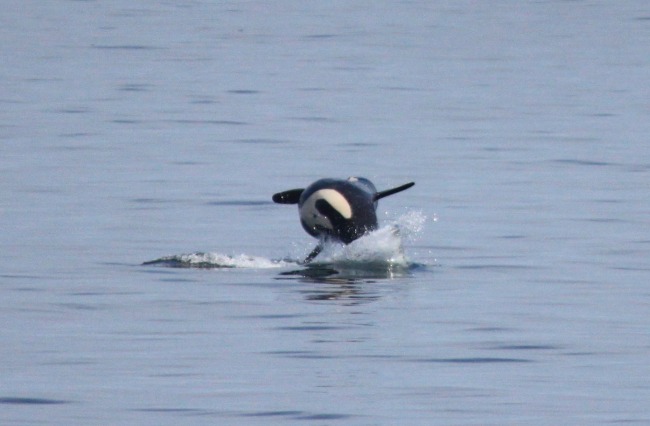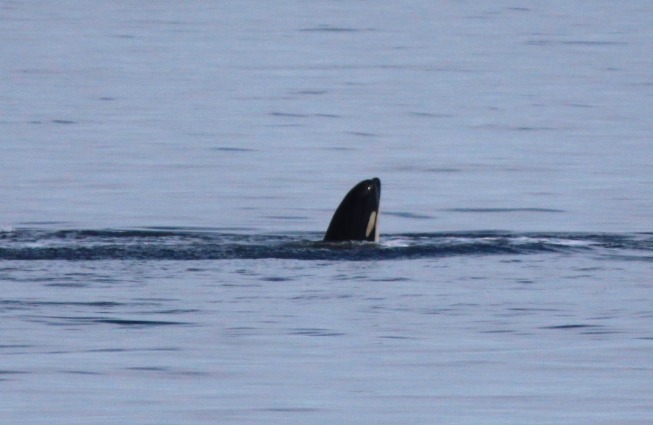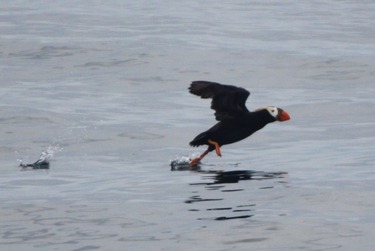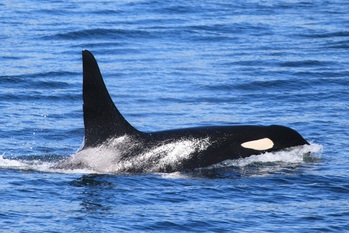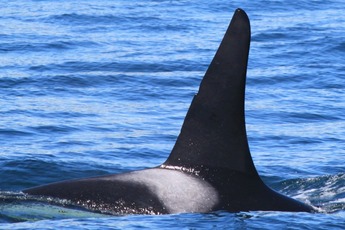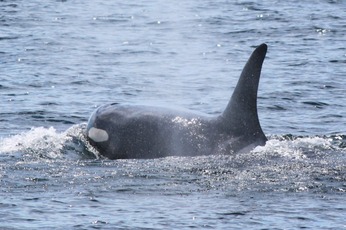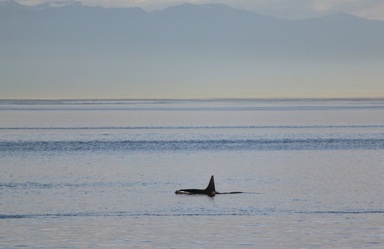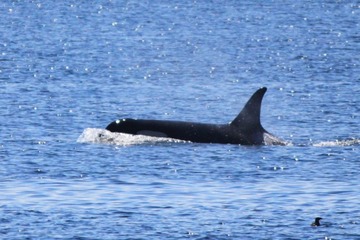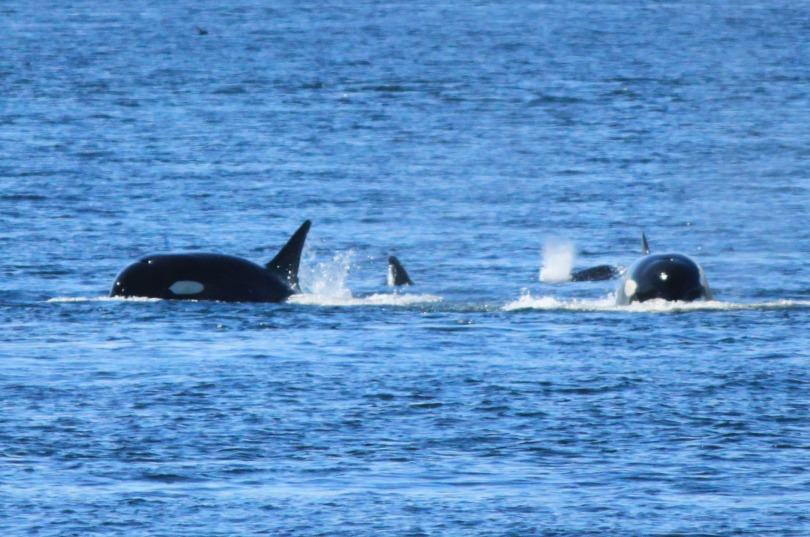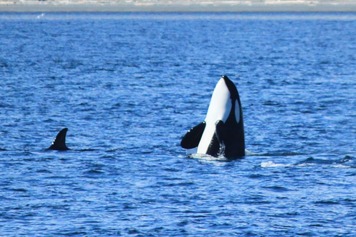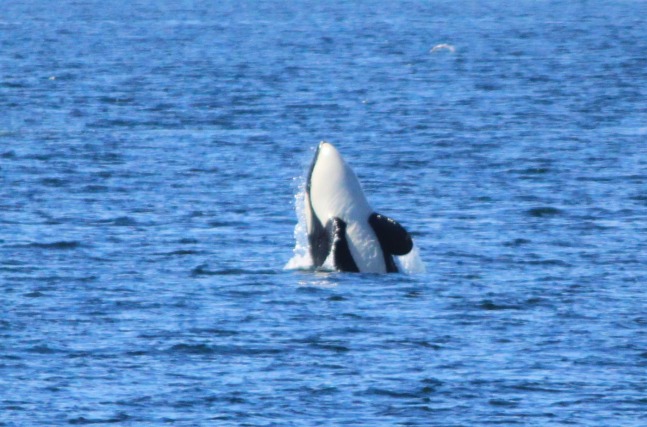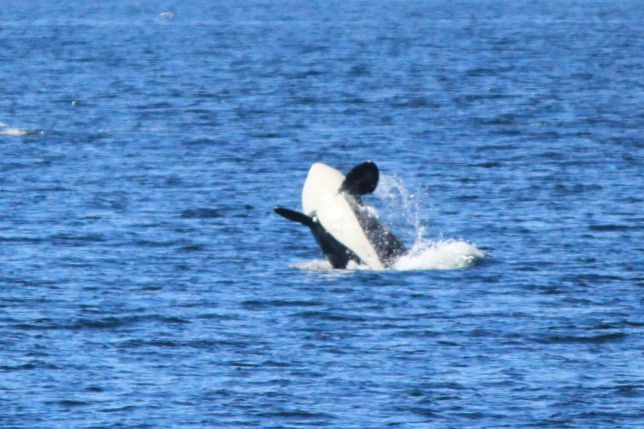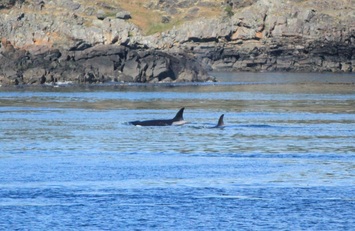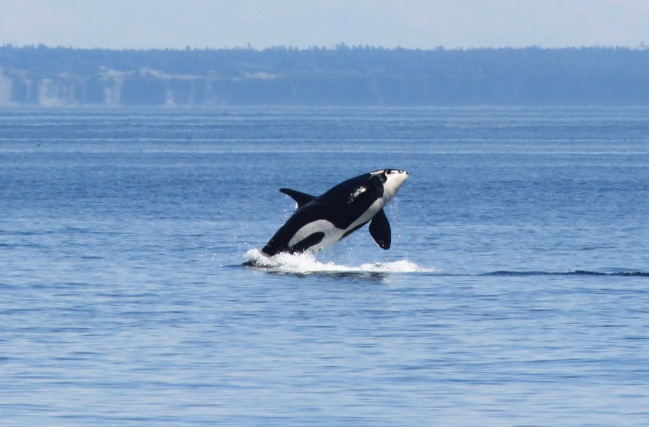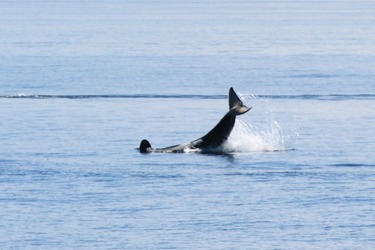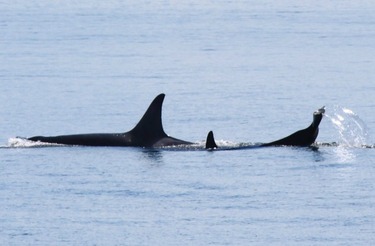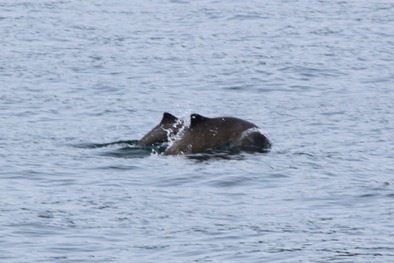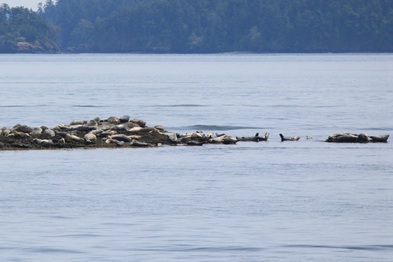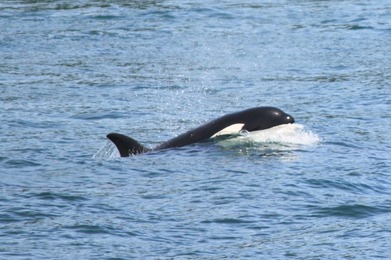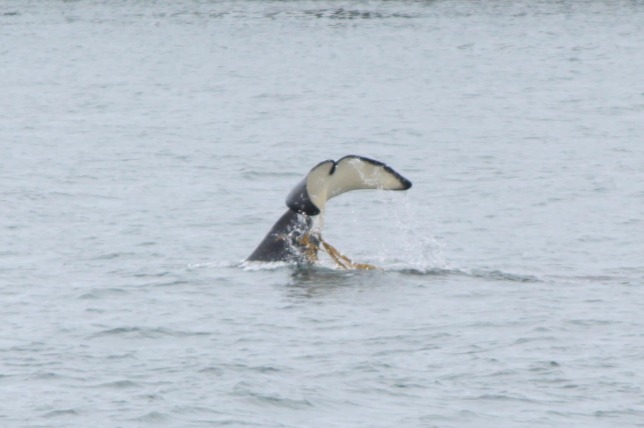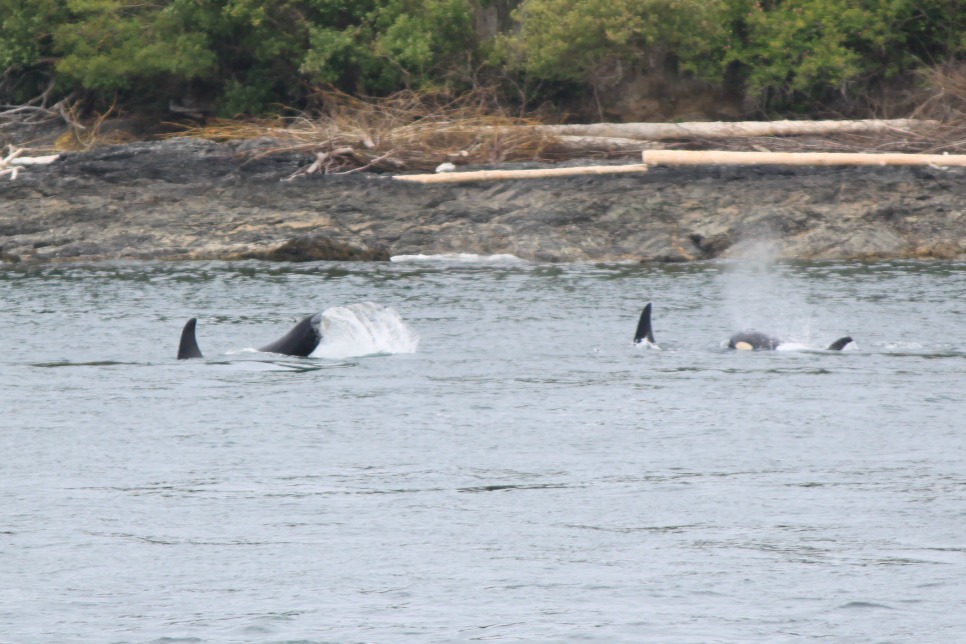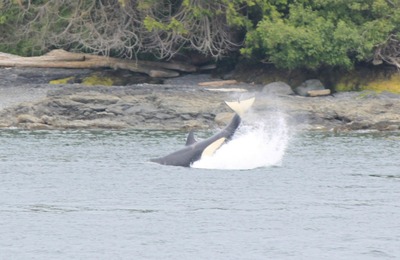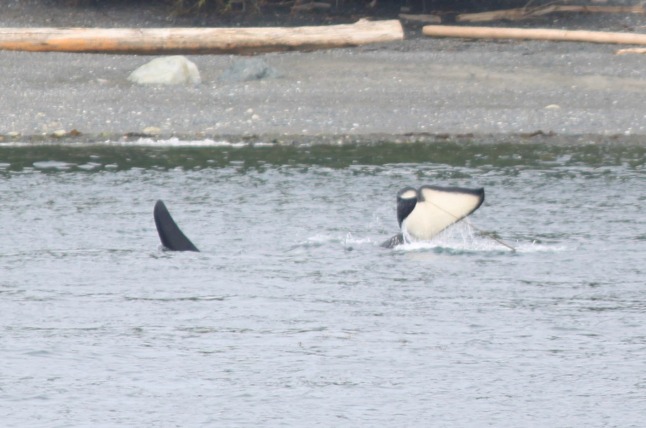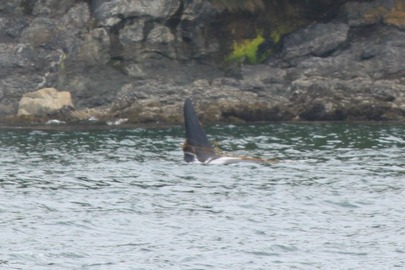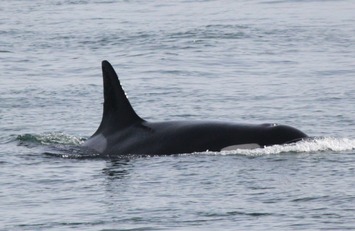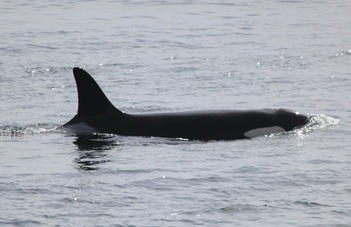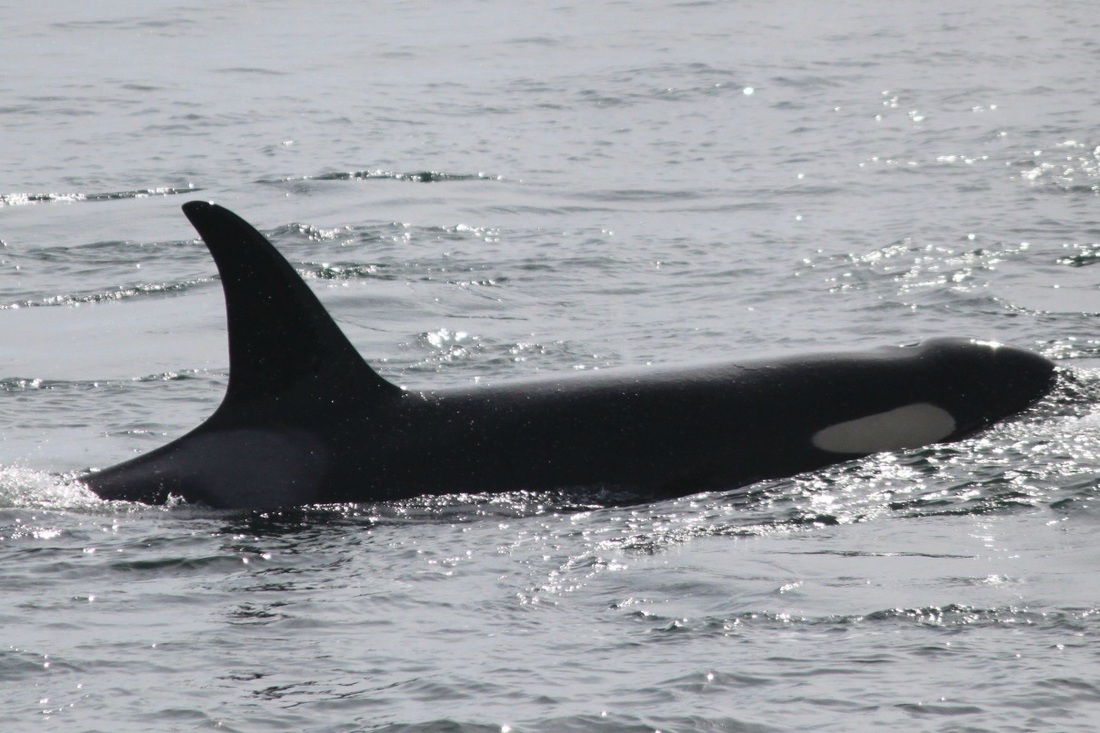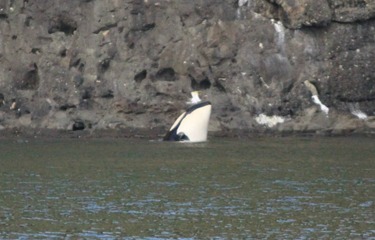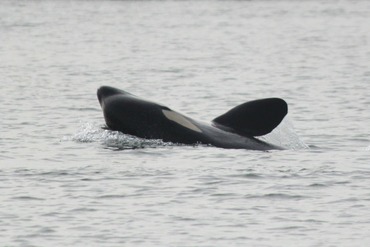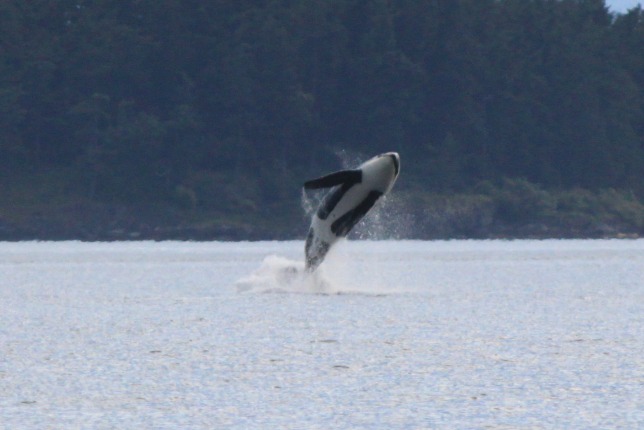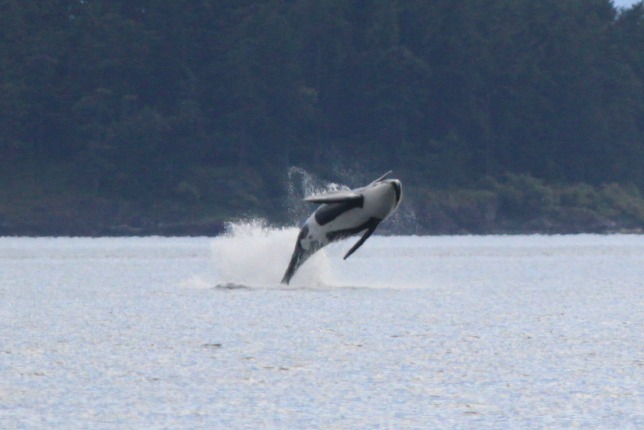After L pod left the area on the morning 6/23/13, I had many great encounters with humpback and minke whales with San Juan Excursions and San Juan Island Whale & Wildlife Tours. On the evening of 6/28/13, L pod made their way back to the West side of San Juan Island and I caught a ride with San Juan Safaris as they headed out to see the orcas. The first orcas we saw were Nugget L55, born in 1977, and her family. A sprouter male from another matriline called Nigel L95 was with them too.
|
I apologize that this post, and the one below it, are out of order. The 6/29/13 encounter should be before this one, and there seems to be no way to re-order them. After L pod left the area on the morning 6/23/13, I had many great encounters with humpback and minke whales with San Juan Excursions and San Juan Island Whale & Wildlife Tours. On the evening of 6/28/13, L pod made their way back to the West side of San Juan Island and I caught a ride with San Juan Safaris as they headed out to see the orcas. The first orcas we saw were Nugget L55, born in 1977, and her family. A sprouter male from another matriline called Nigel L95 was with them too. We then headed down the West side of San Juan Island and saw Lulu L53, born in 1977, and two males named Solstice L89, born in 1993, and Mystery L85, born in 1991. We then came across cousins Cousteau L113, born in 2009 and L119, born in 2012 as they played together. L119 got especially excited and breached/backdived/belly flopped around thirty times in a row. L119 also spy hopped with her mouth open! It is very rare to see the teeth of a wild orca but her teeth look great! We left these two as they continued to play as the sun went down. I hoped they were finding enough Chinook salmon to still be in the area the next day.
1 Comment
I woke up to reports of a large group of orcas heading North past my house on the West side of San Juan Island. I ran out onto the porch and looked for the orcas but could hear them slapping the water farther North of me. They had already passed my house. So I jumped in my car and headed for Lime Kiln State Park up island of me for a close encounter of the orca kind. When the Southern Resident orcas (J,K,and L pod) pass the shoreline of this park they often come with fifteen feet of shore and this time I would not be disappointed. The first orca to swim past was Lulu L53, born in 1977 but she was far offshore. Ophelia L27, born around 1965 was right behind her. The next orcas to swim past was Kasatka L82, and her young son Finn L116. With them were adult males Nyssa L84, Wave Walker L88, and Mega L41. They were all within just feet of the rocky shoreline! The next orcas to swim by were Fluke L105, Surprise L86, and Ino L54, with her daughter Keta L117 and son Coho L108. Crewser L92 and his aunt Ballena L90 were next to swim by shore. These two are the last members of their matriline after Ballena's mother, Baba L26, passed away this year at an estimated age of fifty seven years old. The last L pod members to come close to shore were Marina L47, with her son Mystic L115, and daughter Muncher L91. Any L pod members not mentioned were far offshore. The orcas continued North past the park and as if my day couldn't get any better, it was time for me to go work on the "Odyssey", a San Juan Excursions boat, to teach guests about the orcas and have another amazing encounter. A short time later I was with L pod again. We first saw Matia L77, born in 1987, with her daughter L119, born in 2012, and then got a surprise visit from an adult male known as Mystery L85. We then headed over to check out a group of orcas seemingly socializing together and generally being active. It was three males; Mega L41, Wave Walker L88, Nigel L95, and Kasatka L82 with her daughter Lapis L103, and son Finn L116. Then, Finn L116 started to get very active! It seemed like there maybe was enough Chinook salmon here for them to eat for a little while, but in the morning (7/1/13), L pod was leaving for the open ocean again. I wonder when they will come back?
The morning of 6/23/13 felt empty as I scanned the waters of Haro Strait on the West side of San Juan Island. Soon after, I heard that orcas, the L12's and L22's, were exiting the area through the Strait of Juan De Fuca and headed for the open ocean. When there are days without orcas, like this one, the "Odyssey" of San Juan Excursions, often sets out looking for other wildlife and a baleen whale that is commonly seen in the area called a minke whale. At up to thirty five feet long, these marine mammals are a little larger than the orcas. The topside of a minke whale body is brown or dark grey in color, with a light chevron-like pattern that crosses over the back, just behind the head, which is pointed. The underside of the whale is all white, and white bands can be seen on the tiny pectoral fins. The dorsal fin curves back sharply and is about a foot tall. Each dorsal fin shape is unique to individuals as well as any scars on the body. These whales eat small schooling fish like herring, and sandlance and upon diving they do not show their flukes like some other baleen whales. We often see minkes alone, or in small groups, which is typical for baleen whales. Minkes may not be very social but they are curious; we have had encounters were they come right over to the boat and check us out. On this day we had four different minke whales at Salmon Bank, on the West side of San Juan Island. I was excited to see that one of the minkes was the same one we had seen following orcas from the L12 matriline around the day before. We then got a very rare treat; a tufted puffin! Tufted puffins were common in our area until the population severely declined in the 1980's and 1990's. We now see a tufted puffin once or twice a year. Their decline could be caused by changing oceanic and climatic conditions, effects of introduced species, getting caught in fishing nets, lack of prey, and oil spills. On our way back to the dock, we also got to see many harbor seals in the water as they hunted for salmon, octopus, and other prey. It is always fun to hang out with all the wildlife that we have around San Juan Island besides the orcas. What will tomorrow bring?
Please do not use my photos without permission. Just ask :) Much of L pod returned to San Juan Island during the night of 6/20/13. On 6/21/13, the orcas spent most of the day foraging along the West side of the island for Chinook salmon, and on 6/22/13, I woke up to see two L pod matrilines called the L12's and L22's outside my window as they did the West side shuffle. Once aboard the "Odyssey", of San Juan Excursions, we caught up with members of the L12s near Eagle Point. The first orca we saw was Mega L41, the oldest and largest male of the Southern Resident population. Nearby was Ocean Sun L25, the second oldest female in the Southern Resident orca population, the first being Granny J2, estimated to have been born in 1911. The next orcas we were with were Matia L77 (Mega L41's younger sister), and her calf L119. L119 was looking healthy and is as adorable as ever. We watched the two as they circled and milled about off our bow for a few minutes and that is when something happened that surprised all of us! We had not known that there had even been a minke whale in the area but here one was following Matia and L119, often surfacing in unison with them. This sort of thing has happened a few times this year as well as in the past, but I had only seen it once before, and far away. I wonder if it's the same minke?? A minke whale is a baleen whale that can often be found around San Juan Island and they are just about the same size as the orcas, maybe a little bigger. Since these were Resident orcas who only eat salmon, this minke whale was not on the menu and the minke seemed well aware of this. We watched as the minke followed the two orcas closely for a few minutes and every turn the orcas made, the minke would do the same. Later on, another whale watching boat saw the same minke follow Mega around for twenty minutes.
This encounter made me wonder about the possible interactions happening underwater. Were they socializing? Playing? Was the minke helping herd salmon for the orcas? Were the orcas helping herd herring for the minke? Or was the minke just kind of in the background? Maybe someday we will find out what is happening underwater when minke whales hang out with J, K, and L pod, but for now it's a mystery. - - - - - - - - - - - - - - - - - - - - - - - As the sun was setting on 6/22/13, I got a report of orcas heading toward my house on the West side of the island. It was the L22 matriline, which consists ofSpirit L22, and her two adult sons; Skana L79 and Solstice L89. The water was calm, and there was no sound but the breaths of these three orcas. A great way to end the day. We left the dock aboard the "Odyssey", of San Juan Excursions, with reports of L pod on the West side of San Juan Island. There were also reports of Transient orcas heading our way from Smith Island. When we got on scene with L pod, the orcas were spread over miles and the only L pod members I was able to identify were Surprise L86, born in 1991, and her son Pooka L106, who was born in 2005. While we were with L pod, it was obvious that they were leaving the area after just arriving the day before, which most likely means there is not enough Chinook salmom to sustain them here. Historically, the Southern Residents (J,K, and L pod) could be seen in the area all year long feasting on Chinook salmon, but now they are only seen around San Juan Island in the summer and fall. These orcas are also listed under the endangered species act, and some of the Chinook salmon they depend on for almost their entire diet are endangered as well. If we are unable to save the Chinook salmon, J, K, and L pod are doomed as well. Visit Help The Orcas page to learn more. Then, out of nowhere five different Transient orcas that had not been reported showed up nearby so we headed over to check them out. It is pretty unusual to have Transient and Resident orcas so close together as they are different species of orcas that do not socialize, mate or interact with each other and basically stay out of each others way. The group consisted of T075 with her adult son T075A and another matriline called the T036As. We watched as they made two kills (probably harbor seals) in a span of about ten minutes. After each kill they celebrated with breaches, spy hops, tail slaps, and other playful activities. Just as we were ending our encounter with these Transient orcas as they headed up the West side of San Juan Island, the other group first reported approached from the South East and headed up San Juan Channel, which was the way back to our dock, so we were able to watch the orcas as we headed back home. In this group were two matrilines called the T065As and T075Bs, the same two matrilines we had seen a few days before. Right after we left this group of orcas, they had a harbor seal for lunch as well. What an unusual but awesome day aboard the "Odyssey"!
J and L pod left the area on the night of 6/9/13, and finally after eight days, L pod returned to islands on the morning of 6/17/13. We caught up with them on the "Odyssey", a San Juan Excursions whale watching boat, at Iceberg Point, Lopez Island, as they made their way towards Rosario Strait. The first orca I identified was Mega L41, our oldest, and largest male in the Southern Resident population. Skana L79, his mother Spirit L22, and younger brother Solstice L89 were also nearby. Close to Skana's family was Ophelia L27, Surprise L86 with her son Pooka L106, and Ino L54 with her three children: Indigo L100, Coho L108, and Keta L117. Nyssa L84 was also with these orcas, as well as who I believe to be L119. Farther away I could see Wave Walker L88, and further past him was Mystery L85. All of a sudden all of the orcas we were with got really active with breaches, half breaches, dorsal fins slaps, tail slaps, belly flops, back dives, and even one amazing twisting breach that reminded me of what I had seen spinner dolphins do in Hawai'i. Ophelia breached three times in a row at one point and then did a back dive. Around this time Keta L117, Solstice L89, L119 and others were breaching and doing all sorts of other antics so it was hard to catch all of them. I was also excited to see that Indigo L100, born in 2001, has started to sprout! Hopefully he will grow into a large adult male like Mega!
Please don't use my photos without permission. Just ask :) I woke up on Saturday morning to hear reports of Transients in the area. Luckily, I was working on the San Juan Excursions whale watching boat called the "Odyssey" that day so I hoped we would be able to catch up with them. We departed Friday Harbor, San Juan Island, and headed North East through Peavine Pass and popped out between Orcas, Cypress, and Blakley Island and that is where we found the whales. Transients, unlike salmon eating Resident orcas, eat marine mammals and these two matrilines were working their way around two rocks covered with harbor seals. The seals had hauled out on the rock to escape the jaws of the orcas. As we made our way over to the orcas, a few harbor porpoise sped past us, fleeing the area. The two matrilines, with seven animals altogether, are made up of these individuals:
The orcas made their way around the two seal covered rocks and then headed for the shores of Cypress Island. Once at the island, they found what was probably an unlucky harbor seal and ate it. There was a short celebration by T065A, who did an inverted tail slap, but after that, the orcas went silent again to continue hunting. We left the orcas as they heading down Rosario Strait in search of more prey.
Please do not use my photos without permission. Just ask :) Aboard the "Odyssey" (the San Juan Excursions boat I work on), we met up with all of J pod as they headed North past Lime Kiln State Park on the West side of San Juan Island on 6/8/13. In the lead was Granny J2 and Spieden J8, followed by and in order of Oreo J22 with her family, Shachi J19 and her daughter Eclipse J41,Samish J14 with her matriline, Onyx L87, Slick J16 and her family, Princess Angeline J17 plus her children and grandchildren, and lastly Blackberry J27 with his siblings. The entire time we were with the orcas they seemed in a playful mood, with a few breaches, cartwheels, spy hops and a lot of kelping from the boys. It was great to see the orcas acting so playful while we were with them. This hopefully means they are finding enough salmon around to eat!
Please do not use my photos without permission. Just ask :) After leaving for a few days the L12s/L22s returned with company on the night of 6/4/13. J pod was spotted off the South end of San Juan Island the next morning, as well as almost all the members of L pod. Ino L54 and Grace L2's matriline and Nyssa L84 were the only members not seen, but these whales often travel on their own, so it is not unusual to have them absent while the rest of L pod is seen. After finally spotting the orcas swim past my house in the evening, headed North, I drove to Lime Kiln State Park to have a close encounter of the orca kind. Soon the orcas were just a few feet away from shore as they passed by the park. In front was Granny J2 and the rest of Group A of J pod. Group B and all the L pod members were further behind them. After Group A of J pod passed, Spirit L22 and her son Skana L79 made a close pass shore, followed by Mystery L85. Further offshore the L12s were grouped together and slowly headed North. Suddenly everyone turned around and started to head back South at a quick pace. I waited until Group A passed by me again and then ran up to my car to see if I could view them from another beach South of Lime Kiln. As I drove away from Lime Kiln, I should have looked back to make sure the orcas were still heading South, but I did not. Right after I left, all of the orcas turned around and headed North again. By time I found out, I had missed seeing all of the L pod members who had just come in, make a close pass by Lime Kiln State Park's shoreline. Lesson learned!
Please do not use my photos without permission. Just ask :) This encounter is a great example of what often happens after Southern Resident orcas wake up from "sleeping" for awhile. J pod was inching their way towards Stuart Island, split into Group A and B with about half a mile separating the two. They had been "sleeping" for about two hours already, shoulder to shoulder, synchronizing their breaths, while their brains were partly shut down. Group A had been in the lead until, after a long time, they were passed by Group B. About twenty minutes after this happened, Group B suddenly turned around and met up with Group A. Everyone went underwater for a little bit, then popped up all jumbled together and this is when they woke up. Polaris J28 was the first to spy hop. I don't think I have ever seen so many spy hops in one encounter before! The Southern Resident orcas often seem to celebrate waking up, acting excited and playful. Maybe they are just stretching though.
The L12s/L22s were nowhere to be seen on this day. Please do not use my photos without permission. Just ask :) |
AuthorMelisa Pinnow grew up on San Juan Island in Washington State. She attended The Evergreen State College from 2013 to 2017, receiving a Bachelor of Science in marine biology and ornithology. She has been a certified marine naturalist at San Juan Excursions since 2010. It is her hope that sharing her orca encounters will inspire others to love and protect these magnificent creatures for generations to come. Archives
October 2018
|





